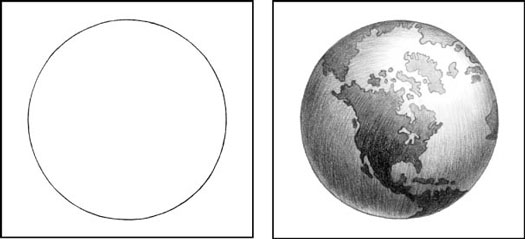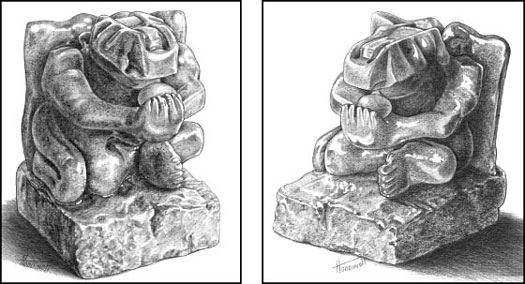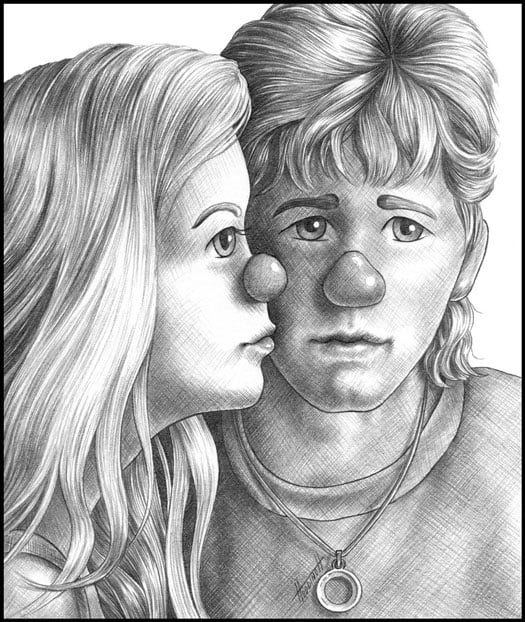Draw a Box Getting Discouraged
Values are the unlike shades of gray betwixt white and black. Artists use values to translate the light and shadows they see into shading, thus creating the illusion of a third dimension.
Hatching and crosshatching are simple and fun techniques for cartoon shading.
A full range of values is the basic ingredient for shading. When you can depict lots of different values, you can brainstorm to add shading, and therefore depth, to your drawings.
With shading, the magical illusion of three-dimensional reality appears on your cartoon paper. Figure ane demonstrates hot to have a unproblematic line drawing of a circle and add shading to transform information technology into the planet World.

You know the objects around you lot are 3-dimensional considering you can walk upwardly to them, see them from all sides, and touch them. Take a moment to wait around y'all at familiar objects. Try to discover why you see their actual three-dimensional forms. Look for the different values created by the light and shadows.
Taking a closer look at calorie-free and shadow
Earlier you tin can depict the appropriate values that illustrate light and shadows correctly, yous demand to be able to visually identify the following:- Low-cal source: The direction from which a ascendant light originates. The placement of this light source affects every aspect of a drawing.
- Shadows: The areas on an object that receive little or no light.
- Bandage shadow: The dark surface area on an adjacent surface where the low-cal is blocked by the solid object.
The calorie-free source tells you where to draw all the low-cal values and shadows.
Figure ii gives you some do in locating the light source, shadows, and cast shadows effectually an object, which in this case is a sculpture. As you lot look at two drawings of the sculpture, ask yourself the following questions:
- Where are the light values? Look for the lightest areas on the object. The very brightest of the lightest values are called highlights.
- Where are the dark values? Night values often reveal the sections of the object that are in shadow. Past locating shadows, you can normally identify the light source.
- Where is the cast shadow? The section of the cast shadow closest to the object is commonly the darkest value in a drawing. By locating an object'southward cast shadow, you can hands observe the management from which the light source originates.

The two drawings in Figure ii accept dissimilar lite sources. Compare them and find the dominant light source in each.
If you guessed that the light is coming from the correct in the first drawing, y'all would be correct. In the second cartoon, the calorie-free originates from the left.
Seeing how a light source affects an actual object is more challenging than examining a drawing. Place an object on a table in a dimly lit room. Shine a powerful flashlight or a lamp (a light source) on the object. Observe information technology from unlike perspectives.
Each time you lot reposition the light source, place the following:- The shadows on the object (dark values)
- The brightest areas (the highlights)
- The light values (areas closer to the low-cal source or non in shadow)
- The bandage shadow (the darkest values)
Exploring contrast in a drawing
Contrast can exist used to make your drawings more three-dimensional by accentuating the light and shadows. By using extremes in values (more light and dark values than heart values) yous create a high-dissimilarity drawing. For a really powerful, strong, and dynamic drawing, you can depict very nighttime shading right next to the light areas.When a drawing has mostly light and center values, information technology is called low contrast. Some drawing subjects need to be soft and gentle. You tin create a very soft drawing and still utilise a full range of values. Recall nigh a white kitten, for instance. Almost of the shading is very light, but the drawing becomes more than powerful if you lot utilise a trivial nighttime shading in a few selective areas, such as the pupils of the optics and the shadows.
Your drawings can announced apartment rather than three-dimensional when y'all apply as well fiddling contrast in values. Unless you lot are trying to achieve a specific mood or want the subject to await flat, ever use a full range of values.
Figure 3 helps you meet contrast while exercising your vision. Take a few moments to explore the low-cal and shadows in this drawing more closely. The face of the daughter is fatigued in profile. The boy's face is a frontal view. Observe how the girl'south profile is in the shadow of the boy'due south face up.The bright calorie-free on the front of her confront presents a strong contrast to the dark shadow on the side of his face. This makes for a powerful visual separation fifty-fifty though the 2 faces seem close together.

Translating values you see into values y'all draw
Almost everything has more than ane value. Depending on the light source, most things have some areas that are very light and others that are quite dark.If you lot look closely at a mound of nighttime globe, you lot notice that it has several different values. If a fresh layer of snow covered this mound of earth, there would still exist lots of values. When you can see a range of different values you lot can draw your subject field in the third dimension.
Squinting to see values and simple shapes
Seeing values is key to drawing in the 3rd dimension. Many artists can visually simplify complex drawing subjects by but squinting their eyes. Squinting helps you screen out details and see simple values and shapes. When y'all can see the shapes created past different values, you lot can draw your field of study more accurately.Await at Figure iv and squint your eyes until the image seems to get out of focus. Compare the darkest values to the lightest, and try to see the abstruse shapes created by the different values.
The second drawing shows what yous may see when you squint. Take annotation of the shapes created by the values.

Turning colors into values with squinting
Many drawing media, such as graphite, are designed for black and white drawings. Yet, almost everything in the earth is in color. You lot need to adjust your visual perceptions to run across these colors every bit shades of grey when drawing.Wouldn't it exist dainty if yous could just press a button in the middle of your brow and magically transform the world from total color to gray values? This ability would certainly make cartoon a lot easier. Thankfully, simply squinting your eyes tin can assistance you develop this skill.
Try these suggestions to help y'all train your mind to translate colors into values:
- Look around you at unlike objects. Focus on only the calorie-free and nighttime areas and non the actual colors. Concentrate on the light and shadows. So squint your optics until you see the values of that object. Accept a mental notation of where the lights and darks are. Call up most how you could draw these darks and lights. Don't become discouraged if you can't exercise information technology right away. With practice, you get improve.
- Find a colored photo with lots of contrast. Squint your eyes to block out the colors and details. In your sketchbook, draw but the unproblematic shapes and values yous encounter. Add shading with only black, white, a light value, and a middle value.
Source: https://www.dummies.com/article/academics-the-arts/art-architecture/drawing/general-drawing/drawing-light-and-shadows-200446